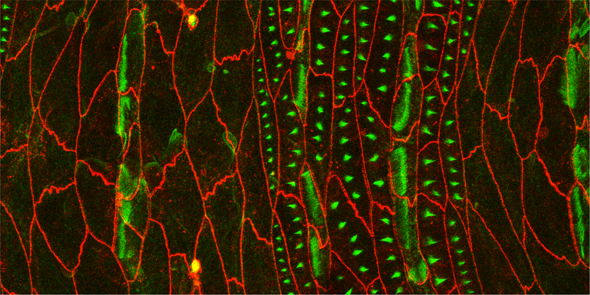
José Casal and I try to understand animal design and pattern formation. An important and rather neglected aspect of development of both animals and plants is vectorial — how do cells know which way to move, how to polarise cell divisions, how to orient cell extensions such as axons, hairs or bristles? We are using Drosophila and studying what must be at least part of this vectorial information and is known as planar cell polarity (PCP). We have found that PCP depends on (at least) two genetic systems (the Dachsous/Fat system and the Starry night (Flamingo)/Frizzled system and are now trying to understand these systems better, both at the cellular and the molecular level. Our approaches include genetic mosaics, genetic engineering as well as observations (confocal microscopy) and experiments on the epidermal cells of living larvae. We are collaborating with David Strutt of the University of Sheffield and his colleagues.
Current research topics include:
-
How does the Ds/Ft system drive planar cell polarity in the living larva of Drosophila?
-
What is the role of the prickle gene, particularly in relation to the two main systems of planar cell polarity?
-
How does localisation of the Dachs protein relate to the two systems of planar cell polarity?
Key Publications
José Casal, Beatriz Ibáñez-Jiménez, Peter A. Lawrence, Planar cell polarity: the prickle gene acts independently on both the Ds/Ft and the Stan/Fz systems. Development 2018
Lawrence P.A. The Making of a Fly: The Genetics of Animal Design. Blackwell Scientific Publications, Oxford, 229 pp. ISBN: 0-632-30048-8. (1992).
Casal, J., Lawrence, P.A. and Struhl, G. Two separate molecular systems, Dachsous/Fat and Starry night/Frizzled, act independently to confer planar cell polarity. Development 133, 4561-4572. (2006).
Brittle, A. L., Repiso, A., Casal, J., Lawrence, P. A., and Strutt, D. Four-Jointed modulates growth and planar polarity by reducing the affinity of Dachsous for Fat. Current Biology, 20, 803–810. (2010).
Rovira M., Saavedra P., Casal J. and Lawrence P.A. Regions within a single epidermal cell of Drosophila can be planar polarised independently. eLife 4: e06303. (2015)
Lawrence P.A. The last 50 years: Mismeasurement and mismanagement are impeding scientific research. Current Topics in Developmental Biology 116: 617-631. (2016).
Search PubMed, Google Scholar or Orcid for more publications by Peter Lawrence, or check his personal site (making-of-a-fly.me) for an up-to-date list.
